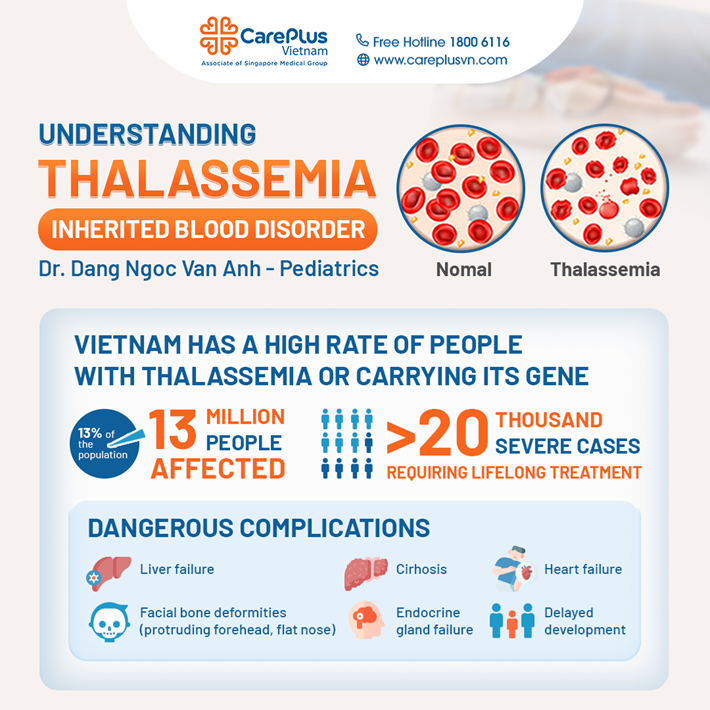Understanding Thalassemia (Inherited Hemolytic Anemia)
According to the National Institute of Hematology and Blood Transfusion in 2022, all 63 provinces and 54 ethnic groups in Vietnam have individuals who carry the thalassemia gene. With over 13% of the population estimated to be carriers, around 14 million people nationwide are thought to carry the gene. In some ethnic groups, the carrier rate is as high as 30-40%, while in the Kinh ethnic group, it’s around 9.8%.

9/19/2024 1:15:17 PM
What is Thalassemia?
Thalassemia is a recessive genetic disorder caused by a defect in hemoglobin production, the protein in red blood cells that carries oxygen throughout the body. In individuals with this condition, red blood cells are affected. Red blood cells are produced inside the bone marrow and use hemoglobin to transport oxygen. When there’s not enough hemoglobin in the blood, it leads to a condition known as anemia.
In thalassemia, genetic defects result in insufficient hemoglobin production. Hemoglobin is made up of two parts: "alpha globin" and "beta globin." There are two types of thalassemia, known as "alpha" and "beta" thalassemia, depending on whether the alpha or beta globin genes are affected. For each type, the severity of the condition can vary.
This condition is globally widespread, with a high prevalence in the Mediterranean, Middle East, and Asia-Pacific regions. Vietnam is one of the countries with a high rate of thalassemia carriers. Thalassemia is one of the most common genetic disorders worldwide, with an estimated 7% of the global population carrying the gene or being affected by this condition.
According to the National Institute of Hematology and Blood Transfusion in 2022, all 63 provinces and 54 ethnic groups in Vietnam have individuals who carry the thalassemia gene. With over 13% of the population estimated to be carriers, around 14 million people nationwide are thought to carry the gene. In some ethnic groups, the carrier rate is as high as 30-40%, while in the Kinh ethnic group, it’s around 9.8%.
Many severe cases are present in infancy, with children potentially dying before birth or being born with severe anemia, requiring lifelong blood transfusions and suffering complications like stunted growth, heart failure, and cirrhosis.
Blood Smear in Thalassemia
- Normal Peripheral Blood Smear: Red blood cells are relatively uniform in size and shape, with the center (indicated by a dashed arrow) occupying about one-third of the cell’s diameter.
- Peripheral Blood Smear in Intermediate Beta Thalassemia: Red blood cells appear smaller, pale, fragmented, and abnormally shaped, with some nucleated red blood cells (indicated by arrows).
Severity of Thalassemia
The severity of thalassemia varies depending on the number of affected genes:
- Transfusion-dependent Thalassemia (Severe): This involves severe anemia, requiring early and regular blood transfusions. It occurs when a child inherits defective genes from both parents, leading to little or no production of beta globin.
- Non-transfusion-dependent Thalassemia (Moderate): This is a milder form of the disease, where affected individuals may require occasional transfusions but not always. It happens when both parents pass on thalassemia beta genes, but one gene still produces some beta globin.
- Thalassemia Trait (Carrier): This form usually has no symptoms, and individuals may not know they are carriers. It occurs when a child inherits a single gene from one parent that produces a small amount of beta globin.
Individuals with any of these conditions can pass the gene on to their children. Whether the child develops thalassemia, and the severity depends on the genes inherited from both parents.
What Are the Symptoms of Thalassemia?
In transfusion-dependent beta thalassemia (severe), symptoms usually appear within the first few months of life. These may include:
- Pale skin
- Irritability or sadness
- Failure to grow as expected
- A swollen or distended abdomen
- Enlarged, deformed facial or skull bones (e.g., a prominent forehead, flat nose, protruding upper jaw)
Some symptoms arise as parts of the body attempt to produce red blood cells due to the shortage. This explains the enlarged abdomen and abnormal bone growth in some cases. Over time, excessive iron accumulation can also occur due to insufficient hemoglobin, causing the body to absorb more iron than needed.
Testing for Thalassemia
Blood tests can confirm if a child has thalassemia and determine the type. Sometimes, repeated testing is necessary to better understand the specific type and the affected genes.
Treatment for Severe Thalassemia
- Blood Transfusions: Required for severe anemia.
While transfusions help manage thalassemia, they can also lead to complications due to iron in the blood. Excess iron from transfusions can accumulate, creating issues for the body.
- Iron Chelation Therapy: Individuals with excess iron need to remove it to prevent damage to organs. Doctors may prescribe oral or injected medications for this purpose.
- Spleen Removal Surgery: Performed when the spleen becomes enlarged, and blood transfusions are less effective.
- Bone Marrow Transplant: The most advanced treatment involves receiving bone marrow cells from a donor, typically a sibling without severe thalassemia. (Even individuals with mild thalassemia can be donors.) However, bone marrow transplants are reserved for severe cases due to the risk of serious side effects, including death.
Researchers are also exploring other treatments that may cure thalassemia. One approach used in Europe involves a patient’s own bone marrow cells, which are modified in the lab to carry a gene that produces functional beta globin. This is called "gene therapy." While only a few people have been treated this way, it may become more widespread in the future.
How Can Thalassemia Patients Maintain Their Health?
- Regular doctor visits for monitoring and adherence to treatment plans.
- Avoiding self-prescribed vitamins or supplements containing iron.
- Taking folic acid as prescribed.
- Avoiding infections.
- Staying up-to-date on vaccinations, especially for patients who have had their spleen removed.
Source: Uptodate 2024 - Patient education: Beta thalassemia_